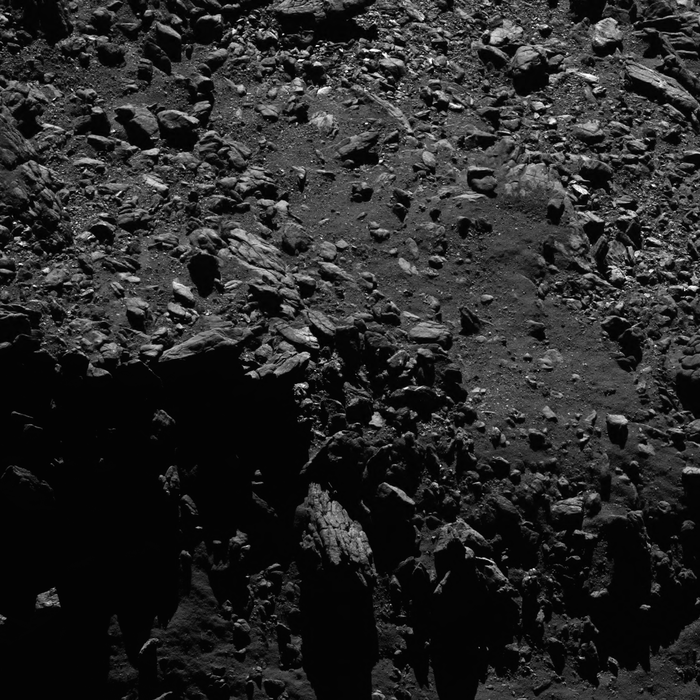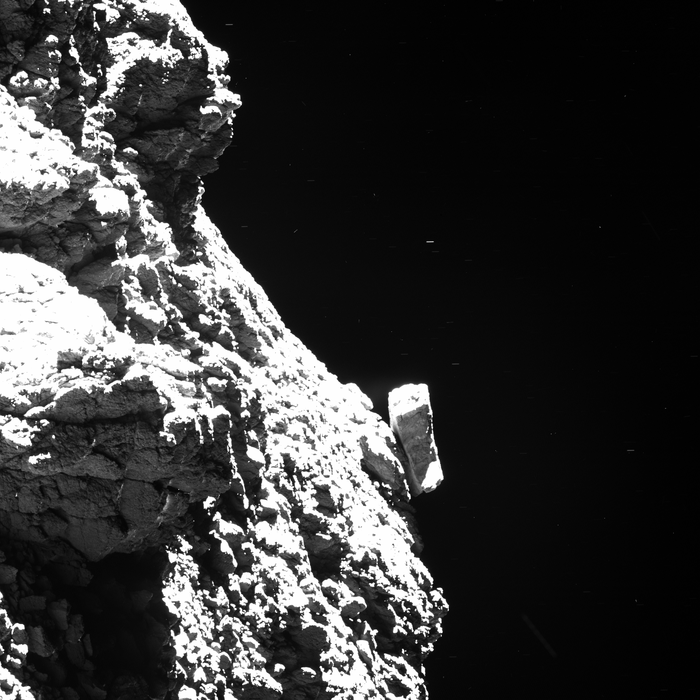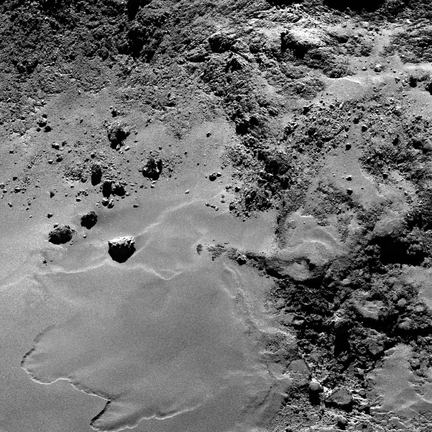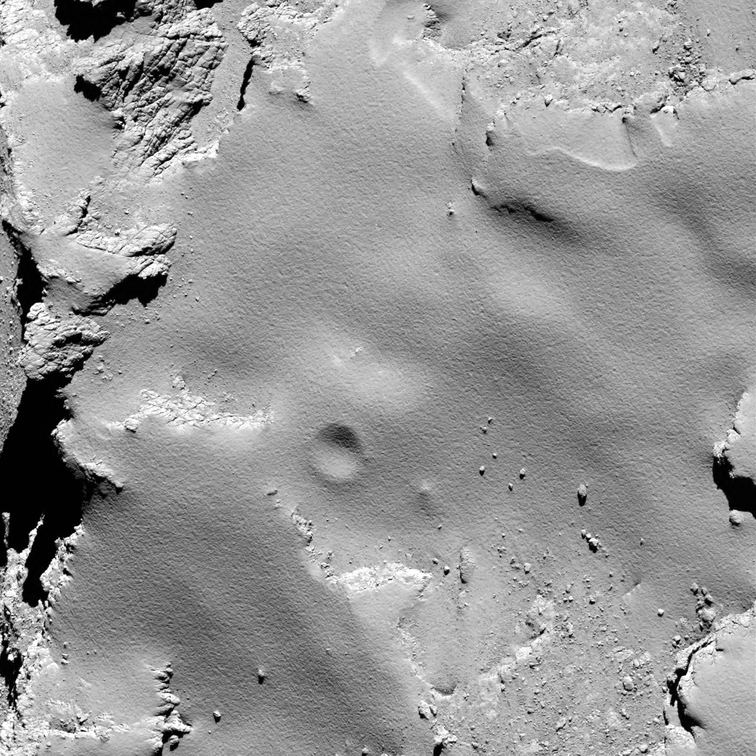It looks like you're using an Ad Blocker.
Please white-list or disable AboveTopSecret.com in your ad-blocking tool.
Thank you.
Some features of ATS will be disabled while you continue to use an ad-blocker.
23
share:
Image taken with the OSIRIS narrow-angle camera at just 2.1 km from the Comet's surface.

This is the image that located Philae lander , those with good eyesight may see its leg sticking out at the top left hand edge

Such a great achievement and pictures of a Comet that until a couple of years ago we could only dream about.
Awesome.
Rosetta Image Archive

This is the image that located Philae lander , those with good eyesight may see its leg sticking out at the top left hand edge

The spacecraft’s trajectory around the comet changed progressively during the final two months of the mission, bringing it closer and closer at its nearest point along elliptical orbits. This allowed some spectacular images to be obtained from within just two kilometres of the surface, highlighting the contrasts in exquisite detail between the smooth and dusty terrain, and more consolidated, fractured comet material.
One particularly memorable sets of images captured in this period were those of Rosetta’s lander Philae following the painstaking effort over the previous years to determine its location. With Rosetta flying so close, challenging conditions associated with the dust and gas escaping from the comet, along with the topography of the local terrain, caused problems with getting the best line-of-sight view of Philae’s expected location, but the winning shot was finally captured just weeks before the mission end.
In the mission’s last hours as Rosetta moved even closer towards the surface of the comet, it scanned across an ancient pit and finally sent back images showing what would become its resting place. Even after the spacecraft was silent, the team were able to reconstruct a last image from the final telemetry packets sent back when Rosetta was within about 20 m of the surface.
www.esa.int...
Such a great achievement and pictures of a Comet that until a couple of years ago we could only dream about.
Awesome.
Rosetta Image Archive
a reply to: gortex
Fantastic images! It never ceases to amaze me.
We have learned so much about comets that they are unrecognizable from what we thought they were in my opinion. No longer the dirty snowballs that originated in the outer solar system, at least not as appearing in images like these and evidenced from samples collected by the Stardust mission back in 2004.
Next mission; Collect core samples. Now wouldn't that be something!
I would like to add some images I found from the link you posted;
Created on Monday 29 September 2014

Created on Wednesday 27 July 2016
Using the rock in the left of center as a reference I noticed the dusty looking material has changed over time (about 10 months), I rotated the second image. A lot of material is missing. I now wish I had the time to compare other images.
Fantastic images! It never ceases to amaze me.
We have learned so much about comets that they are unrecognizable from what we thought they were in my opinion. No longer the dirty snowballs that originated in the outer solar system, at least not as appearing in images like these and evidenced from samples collected by the Stardust mission back in 2004.
Next mission; Collect core samples. Now wouldn't that be something!
I would like to add some images I found from the link you posted;
Created on Monday 29 September 2014

Created on Wednesday 27 July 2016

Using the rock in the left of center as a reference I noticed the dusty looking material has changed over time (about 10 months), I rotated the second image. A lot of material is missing. I now wish I had the time to compare other images.
edit on 6/24/2018 by Devino because: added
images
originally posted by: gortex
Image taken with the OSIRIS narrow-angle camera at just 2.1 km from the Comet's surface.
This is a good view of what is called rubble mantle. It forms as the frozen volatiles sublimate and kick up dust and rock, which then coat the surface.

This explain why comets look ice-free and rocky like asteroids.
a reply to: wildespace
Thanks for that explanation. I was wondering why that comet looked that way and I haven’t read anything about them being anything different than the “dirty snowball” description.
Thanks for that explanation. I was wondering why that comet looked that way and I haven’t read anything about them being anything different than the “dirty snowball” description.
Wow, over 129,000 images in the image archive link in the op!
So, if humans could do this, does that mean we could use gravitational "nudging" to move an object away from an Earth-impact trajectory?
Cause that would be pretty lame if we got taken out or taken down several pegs, whilst arguing about something else many orders of magnitude less important than our survival as a species.
So, if humans could do this, does that mean we could use gravitational "nudging" to move an object away from an Earth-impact trajectory?
Cause that would be pretty lame if we got taken out or taken down several pegs, whilst arguing about something else many orders of magnitude less important than our survival as a species.
Do you know what the composition of that material is? Sand, silica and carbon, perhaps? I have noticed that it gets removed over time creating large escarpments as seen in the images from my previous post.
originally posted by: wildespace
originally posted by: 3n19m470
Wow, over 129,000 images in the image archive link in the op!
A real treasure trove there, for perusal over years to come.
I think I found an impact crater! Link
Then there are, what looks like, sand dunes.

It seems difficult to explain these features by way of jetting from sublimating ice. Do you know of a better explanation?
Hopefully I'm able to log back on sometime over the next week but if not I definitely have something to think about.
a reply to: wildespace
I did a little search and found this article.
Comet surface changes before Rosetta’s eyes
So "jetting" could cause some of it but it's at a faster rate than expected. With so many images maybe there are some showing the material being ejected.
I did a little search and found this article.
Comet surface changes before Rosetta’s eyes
Changes in fine grain material. It doesn't say what the material is but it is evident from the linked images that there are changes. Material is either collapsing in or being ejected away, with the low 'g' environment I would be inclined to think ejection seems more likely.
in June 2015, just two months before perihelion, Rosetta scientists started noticing important changes on the surface of the nucleus itself. These very significant alterations have been seen in Imhotep, a region containing smooth terrains covered by fine-grained material as well as large boulders, located on 67P/C-G’s large lobe.
I added the bold text.
“These spectacular changes are proceeding extremely rapidly, with the rims of the features expanding by a few tens of centimetres per hour. This highlights the complexity of the physical processes involved,” adds Olivier.
The sublimation of volatile species is clearly an important factor, as colour images of this region reveal the signature of exposed ice on some of the rims of the newly-formed surface features. The rapid rate of expansion is unexpected, however: models of sunlight-driven sublimation would predict erosion rates of just a few centimetres per hour, and thus the scientists believe that additional mechanisms are required to explain the observations.
So "jetting" could cause some of it but it's at a faster rate than expected. With so many images maybe there are some showing the material being ejected.
The ejected material might not be reflecting light or perhaps it is collapsing inward. The idea that, "additional mechanisms are required to explain the observations", seems very interesting.
The erosion could be accompanied by increased rates of gas outflow, including H2O, CO2, or CO. The scientists also searched in OSIRIS images for evidence of increased dust rising from Imhotep as the surface morphology evolved, but did not find any.
Yeah, that comet proved to be a very dynamic environment.
I think the dunes were formed through such an activity, perhaps through surface shrinking, or through some active outgassing disturbing the surface.
Just spotted something notable in the Wikipedia article:
So, a comet like this formed in the early days of the Solar System, and far from the Sun.
A fracture in the neck region was also observed to grow in size; boulders tens of meters wide were displaced, sometimes travelling more than 100 meters; and patches of the ground were removed to expose new features. A number of collapsing cliffs have also been observed. One notable example in December 2010 was captured by Rosetta's NAVCAM as a bright patch of light shining from the comet. Rosetta scientists determined that a large cliff had collapsed, making it the first landslide on a comet known to be associated with an outburst of activity.
I think the dunes were formed through such an activity, perhaps through surface shrinking, or through some active outgassing disturbing the surface.
Just spotted something notable in the Wikipedia article:
One of the most outstanding discoveries of the mission so far is the detection of large amounts of free molecular oxygen (O2) gas surrounding the comet. Current solar system models suggest the molecular oxygen should have disappeared by the time 67P was created, about 4.6 billion years ago in a violent and hot process that would have caused the oxygen to react with hydrogen and form water. Molecular oxygen has never before been detected in cometary comas. In situ measurements indicate that the O2/H2O ratio is isotropic in the coma and does not change systematically with heliocentric distance, suggesting that primordial O2 was incorporated into the nucleus during the comet's formation. Detection of molecular nitrogen (N2) in the comet suggests that its cometary grains formed in low-temperature conditions below 30 K (−243.2 °C; −405.7 °F).
So, a comet like this formed in the early days of the Solar System, and far from the Sun.
originally posted by: Devino
Do you know what the composition of that material is? Sand, silica and carbon, perhaps?
Just found this through Google:
The dust that comet 67P/Churyumov-Gerasimenko emits into space consists to about one half of organic molecules. The dust belongs to the most pristine and carbon-rich material known in our solar system and has hardly changed since its birth.
[...]
As the study shows, organic molecules are among those ingredients at the top of the list. These account for about 45 percent of the weight of the solid cometary material. "Rosetta’s comet thus belongs to the most carbon-rich bodies we know in the solar system," says MPS scientist and COSIMA team member Dr. Oliver Stenzel. The other part of the total weight, about 55 percent, is provided by mineral substances, mainly silicates.
www.mps.mpg.de...
edit on 30-6-2018 by wildespace because: (no reason given)
new topics
-
Hate makes for strange bedfellows
US Political Madness: 43 minutes ago -
Who guards the guards
US Political Madness: 3 hours ago -
Has Tesla manipulated data logs to cover up auto pilot crash?
Automotive Discussion: 5 hours ago -
whistleblower Captain Bill Uhouse on the Kingman UFO recovery
Aliens and UFOs: 10 hours ago
top topics
-
Lawsuit Seeks to ‘Ban the Jab’ in Florida
Diseases and Pandemics: 17 hours ago, 22 flags -
CIA botched its handling of sexual assault allegations, House intel report says
Breaking Alternative News: 15 hours ago, 10 flags -
whistleblower Captain Bill Uhouse on the Kingman UFO recovery
Aliens and UFOs: 10 hours ago, 10 flags -
Who guards the guards
US Political Madness: 3 hours ago, 6 flags -
Hate makes for strange bedfellows
US Political Madness: 43 minutes ago, 6 flags -
1980s Arcade
General Chit Chat: 12 hours ago, 5 flags -
Deadpool and Wolverine
Movies: 13 hours ago, 4 flags -
Teenager makes chess history becoming the youngest challenger for the world championship crown
Other Current Events: 14 hours ago, 3 flags -
Has Tesla manipulated data logs to cover up auto pilot crash?
Automotive Discussion: 5 hours ago, 1 flags
active topics
-
Candidate TRUMP Now Has Crazy Judge JUAN MERCHAN After Him - The Stormy Daniels Hush-Money Case.
Political Conspiracies • 648 • : Vermilion -
1980s Arcade
General Chit Chat • 12 • : Drugstorecowboy56 -
"We're All Hamas" Heard at Columbia University Protests
Social Issues and Civil Unrest • 218 • : Ohanka -
Hate makes for strange bedfellows
US Political Madness • 2 • : budzprime69 -
New whistleblower Jason Sands speaks on Twitter Spaces last night.
Aliens and UFOs • 41 • : baablacksheep1 -
whistleblower Captain Bill Uhouse on the Kingman UFO recovery
Aliens and UFOs • 11 • : baablacksheep1 -
IDF Intel Chief Resigns Over Hamas attack
Middle East Issues • 37 • : TheWoker -
MULTIPLE SKYMASTER MESSAGES GOING OUT
World War Three • 93 • : Oldcarpy2 -
Republican Voters Against Trump
2024 Elections • 281 • : Justoneman -
Who guards the guards
US Political Madness • 1 • : JAY1980
23

